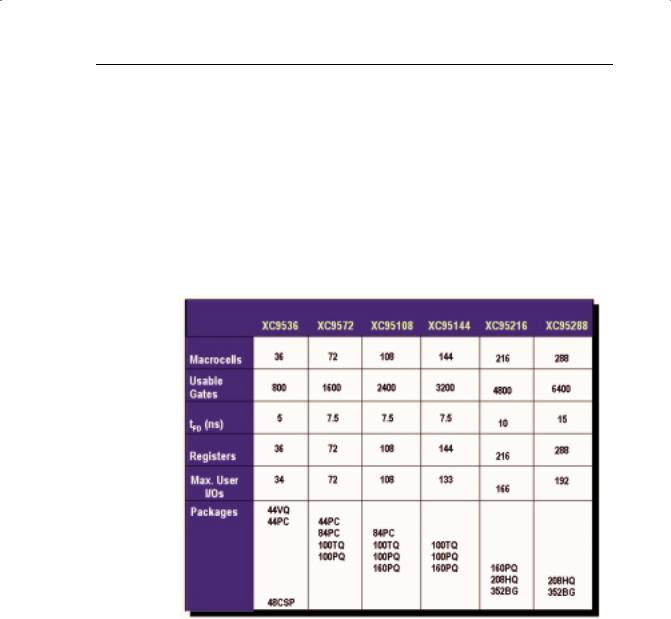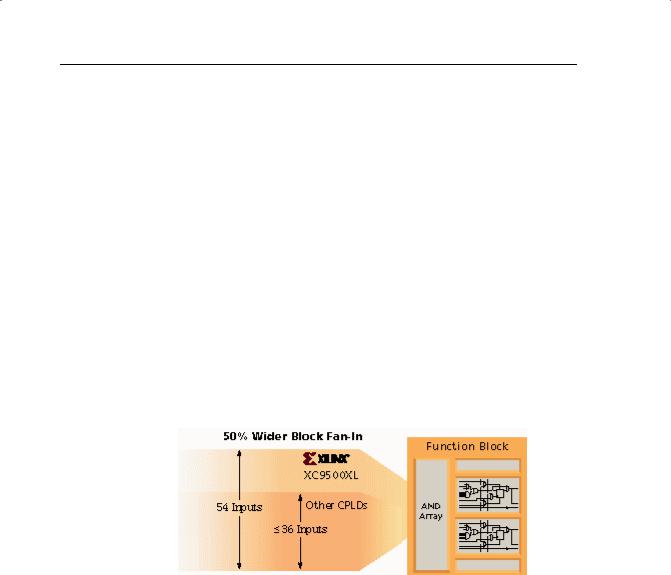
- •Navigating This Book
- •Table of Contents
- •Introduction
- •The History of Programmable Logic
- •Complex Programmable Logic Devices (CPLDs)
- •Why Use a CPLD?
- •Field Programmable Gate Arrays (FPGAs)
- •Design Integration
- •The Basic Design Process
- •HDL File Change Example
- •Before (16 x 16 multiplier):
- •After (32 x 32 multiplier):
- •Intellectual Property (IP) Cores
- •Design Verification
- •Xilinx Solutions
- •Introduction
- •Xilinx Devices
- •Platform FPGAs
- •Virtex FPGAs
- •Virtex-II Pro FPGAs
- •Virtex FPGAs
- •Spartan FPGAs
- •Spartan-3 FPGAs
- •Spartan-IIE FPGAs
- •Spartan-IIE Architectural Features
- •Xilinx CPLDs
- •XC9500 ISP CPLD Overview
- •XC9500XL 3.3V Family
- •XC9500XV 2.5V CPLD Family
- •CoolRunner Low-Power CPLDs
- •CoolRunner-II CPLDs
- •CoolRunner Reference Designs
- •Military and Aerospace
- •Automotive and Industrial
- •Design Tools
- •Design Entry
- •Synthesis
- •Implementation and Configuration
- •Board-Level Integration
- •Verification Technologies
- •Advanced Design Techniques
- •Embedded SW Design Tools Center
- •Xilinx IP Cores
- •Web-Based Information Guide
- •End Markets
- •Silicon Products and Solutions
- •Design Resources
- •System Resources
- •Xilinx Online (IRL)
- •Configuration Solutions
- •Processor Central
- •Tools and Partnerships
- •Memory Corner
- •Silicon
- •Design Tools and Boards
- •Technical Literature and Training
- •Connectivity Central
- •High-Speed Design Resources
- •Signal Integrity Tools
- •Partnerships
- •Signal Integrity
- •Services
- •Xilinx Design Services
- •Education Services
- •Live E-Learning Environment
- •Day Segment Courses
- •Computer-Based Training (CBT)
- •University Program
- •Design Consultants
- •Technical Support
- •Module Descriptions
- •WebPACK Design Suite
- •WebPACK Design Entry
- •WebPACK StateCAD
- •WebPACK MXE Simulator
- •WebPACK HDL Bencher Tool
- •WebPACK FPGA Implementation Tools
- •WebPACK CPLD Implementation Tools
- •WebPACK iMPACT Programmer
- •WebPACK ChipViewer
- •XPower
- •WebPACK CD-ROM Installation
- •Getting Started
- •Licenses
- •Projects
- •Summary
- •Introduction
- •Design Entry
- •The Language Template
- •Close the Language Templates
- •Edit the Counter Module
- •Save the Counter Module
- •Functional Simulation
- •State Machine Editor
- •Top-Level VHDL Designs
- •Top-Level Schematic Designs
- •ECS Hints
- •I/O Markers
- •Implementing CPLDs
- •Introduction
- •Synthesis
- •Constraints Editor
- •CPLD Reports
- •Timing Simulation
- •Configuration
- •Implementing FPGAs
- •Introduction
- •Synthesis
- •The Constraints File
- •FPGA Reports
- •Programming
- •Summary
- •Design Reference Bank
- •Introduction
- •Get the Most out of Microcontroller-Based Designs
- •Conventional Stepper Motor Control
- •Using a Microcontroller to Control a Stepper Motor
- •Stepper Motor Control Using a CPLD
- •PC-Based Motor Control
- •Design Partitioning
- •Conclusion
- •Documentation and Example Code
- •Website Reference
- •ACRONYMS
- •GLOSSARY OF TERMS

XILINX SOLUTIONS
Xilinx CPLDs
Currently, Xilinx offers CPLD products in two categories: XC9500 and CoolRunner devices. To choose a CPLD that's right for you, review the product features below to identify the product family that fits your application. You should also review the selection considerations to choose the device that best meets your design criteria.
Product Features:
XC9500 Device – The XC9500 ISP CPLD families take complex programmable logic devices to new heights of performance, features, and flexibility.
These families deliver industry-leading speeds while providing the flexibility of enhanced customer-proven pin-locking architecture, along with extensive IEEE Std.1149.1 JTAG Boundary Scan support. This CPLD family is ideal for high-speed, low-cost designs.
CoolRunner Device – The CoolRunner CPLD families offer extreme low power, making them the leaders in an all-new market segment: portable electronics.
With standby current in the low micro amps and minimal operational power consumption, these parts are ideal for any application is that is especially power sensitive, such as battery-powered or portable applications.
The CoolRunner-II CPLD extends usage as it offers system-level features such as LVTTL and SSTL, clocking modes, and input hysteresis.
Selection Considerations:
To decide which device best meets your design criteria, take a minute to jot down your design specs (using the list below as a criteria reference). Next, go to a specific product family page to get more detailed information about the device you need.
Density – Each part gives an equivalent “gate count,” or estimate of the logic density of the part.
Number of Registers – Count up the number of registers you need for your counters, state machines, registers, and latches. The number of macrocells in the device must be at least this large.
Number of I/O Pins – How many inputs and outputs does your design need?
Speed Requirements – What is the fastest combinatorial path in your design? This will determine the Tpd (in nanoseconds) of the device. What is the fastest sequential circuit in your design? This will tell you what fMax you need.
Package – What electromechanical constraints are you under? Do you need the smallest ball grid array package possible, or can you use a more ordinary QFP? Or are you prototyping and need to use a socketed device, such as a PLCC package?
Xilinx • 41

PROGRAMMABLE LOGIC DESIGN: QUICK START HANDBOOK • CHAPTER 2
Low Power – Is your end product batteryor solar-powered? Does your design require the lowest power devices possible? Do you have heat dissipation concerns?
System-Level Functions – Does your board have multi-voltage devices? Do you need to level shift between these devices? Do you need to square up clock edges? Do you need to interface to memories and microprocessors?
XC9500 ISP CPLD OVERVIEW
The high-performance, low-cost XC9500 families of Xilinx CPLDs are targeted for leading-edge systems that require rapid design development, longer system life, and robust field upgrade capability.
The XC9500 families range in density from 36 to 288 macrocells and are available in 2.5-volt (XC9500XV), 3.3-volt (XC9500XL) and 5-volt (XC9500) versions.
These devices support ISP, which allows manufacturers to perform unlimited design iterations during the prototyping phase, extensive system in-board debugging, program and test during manufacturing, and field upgrades.
Based on advanced process technologies, the XC9500 families provide fast, guaranteed timing; superior pin locking; and a full JTAG-compliant interface. All XC9500 devices have excellent quality and reliability characteristics with a 10,000 program/erase cycle endurance rating and 20-year data retention.
XC9500 5V Family
The XC9500 ISP CPLD family features six devices ranging from 36 to 288 macrocells, with a wide variety of package combinations that both minimize board space and maintain package footprints as designs grow or shrink.
The I/O pins allow direct interfacing to both 3- and 5-volt systems, while the latest in compact, easy-to-use CSP and BGA packaging gives you access to as many as 192 signals.
Flexible Pin-Locking Architecture
XC9500 devices, in conjunction with our fitter software, give you the maximum in routeability and flexibility while maintaining high performance. The architecture is feature-rich, including individual product term (p-term) output enables, three global clocks, and more p-terms per output than any other CPLD.
The proven ability of the architecture to adapt to design changes while maintaining pin assignments has been demonstrated in countless real-world customer designs since the introduction of the XC9500 family.
Full IEEE 1149.1 JTAG Development and Debugging Support
The JTAG capability of the XC9500 family is the most comprehensive of any CPLD on the market. It features the standard support including BYPASS, SAMPLE/PRELOAD, and EXTEST.
Xilinx • 42

XILINX SOLUTIONS
Additional Boundary Scan instructions, not found in any other CPLD, include INTEST (for device functional test), HIGHZ (for bypass), and USERCODE (for program tracking), for maximum debugging capability.
The XC9500 family is supported by a wide variety of industry-standard third-party development and debugging tools including Corelis, JTAG Technologies, and Asset Intertech. These tools allow you to develop Boundary Scan test vectors to interactively analyze, test, and debug system failures. The family is also supported on all major ATE platforms, including Teradyne, Hewlett Packard, and Genrad.
XC9500 Product Overview Table
TABLE 2-2: XC9500 PRODUCT OVERVIEW
XC9500XL 3.3V FAMILY
The XC9500XL CPLD family is targeted for leading-edge systems that require rapid design development, longer system life, and robust field upgrade capability.
This 3.3V ISP family provides unparalleled performance and the highest programming reliability, with the lowest cost in the industry.
XC9500XL CPLDs also complement the higher-density Xilinx FPGAs to provide a total logic solution, within a unified development environment. The
Xilinx • 43

PROGRAMMABLE LOGIC DESIGN: QUICK START HANDBOOK • CHAPTER 2
XC9500XL family is fully WebPOWERED via its free WebFITTER CPLD design fitting tool and WebPACK ISE software.
Family Highlights
•Lowest cost per macrocell
•State-of-the-art pin-locking architecture
•Highest programming reliability reduces system risk
•Complements Xilinx 3.3V FPGA families
Performance
•5 ns pin-to-pin speed
•222 MHz system frequency
Powerful Architecture
•Wide 54-input function blocks
•As many as 90 product-terms per macrocell
•Fast and routable Fast CONNECT™ II switch matrix
•Three global clocks with local inversion
•Individual OE per output, with local inversion
FIGURE 2-19: XC9500XL BLOCK FAN-IN
Highest Reliability
•Endurance rating of 10,000 cycles
•Data retention rating of 20 years
•Immune from "ISP Lock-Out" failure mode
•Allows arbitrary mixed-power sequencing and waveforms
•
Advanced Technology
• Third-generation, proven CPLD technology
Xilinx • 44
